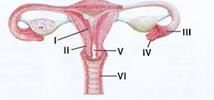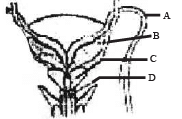31 Years NEET Previous Year Questions: Human Reproduction - 2 - NEET MCQ
25 Questions MCQ Test - 31 Years NEET Previous Year Questions: Human Reproduction - 2
The figure given below depicts a diagrammatic sectional view of the female reproductive system of humans. Which one set of three parts out of I-VI have been correctly identified ? [2011]


The testes in humans are situated outside the abdominal cavity insides pouch called scrotum. The purpose served is for [2011]
If for some reason, the vasa efferentia in the human reproductive system gets blocked, the gametes will not be transported from [2011]
The part of fallopian tube closest to the ovary is [2010]
Which one of the following statements about morula in humans is correct? [2010]
Which one of the following statements about human sperm is correct? [2010]
The second maturation division of the mammalian ovum occurs [2010]
The first movements of the foetus and appearance of hair on its head are usually observed during which month of pregnancy? [2010]
The signals for parturition originate from
[2010]
The permissible use of the technique amniocentesis is for
[2010]
Seminal plasma in human males is rich in :
[2010]
Sertoli cells are found in
[2010]
In vitro fertilisation is a technique that involves transfer of which one of the following into the fallopian tube?
[2010]
A change in the amount of yolk and its distribution in the egg will affect [2009]
Which one of the following is the most likely root cause why menstruation is not taking place in regularly cycling human female? [2009]
The correct sequence of spermatogenetic stages leading to the formation of sperms in a mature human testes is: [2009]
Foetal ejection reflex in human female is induced by [2009]
Given below is a diagrammatic sketch of a portion of human male reproductive system. Select the correct set of the names of the parts labelled A, B, C, D.

[2009]
Seminal plasma in human is rich in [2009]
Which one of the following is the correct matching of the events occurring during menstrual cycle? [2009]
In humans, at the end of the first meiotic division, the male germ cells differentiate into the [2008]
Which extra-embryonic membrane in humans prevents desiccation of the embryo inside the uterus? [2008]
Which one of the following statements is incorrect about menstruation? [2008]
Vasa efferentia are the ductules leading from [2008]
What happens during fertilization in humans after many sperms reach close to the ovum? [2008]














